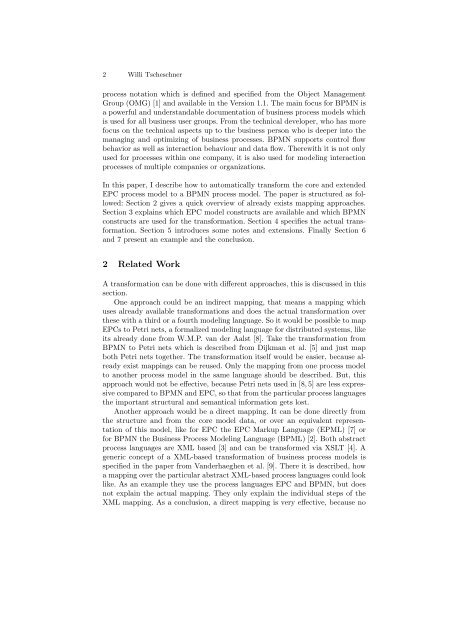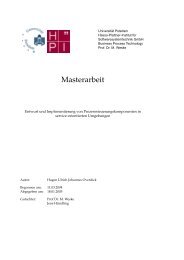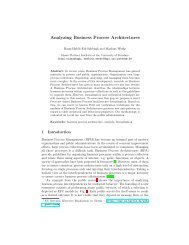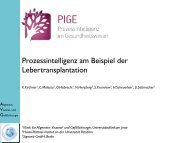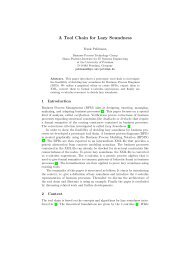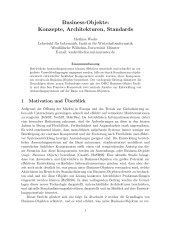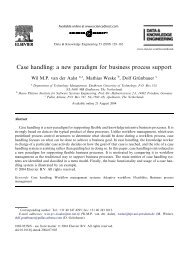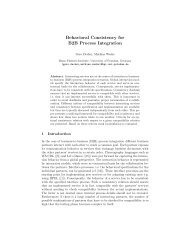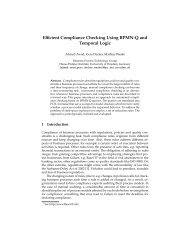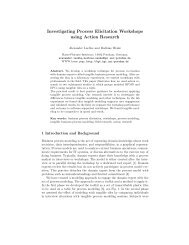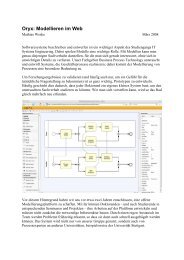Transformation from EPC to BPMN - Business Process Technology ...
Transformation from EPC to BPMN - Business Process Technology ...
Transformation from EPC to BPMN - Business Process Technology ...
Create successful ePaper yourself
Turn your PDF publications into a flip-book with our unique Google optimized e-Paper software.
2 Willi Tscheschner<br />
process notation which is defined and specified <strong>from</strong> the Object Management<br />
Group (OMG) [1] and available in the Version 1.1. The main focus for <strong>BPMN</strong> is<br />
a powerful and understandable documentation of business process models which<br />
is used for all business user groups. From the technical developer, who has more<br />
focus on the technical aspects up <strong>to</strong> the business person who is deeper in<strong>to</strong> the<br />
managing and optimizing of business processes. <strong>BPMN</strong> supports control flow<br />
behavior as well as interaction behaviour and data flow. Therewith it is not only<br />
used for processes within one company, it is also used for modeling interaction<br />
processes of multiple companies or organizations.<br />
In this paper, I describe how <strong>to</strong> au<strong>to</strong>matically transform the core and extended<br />
<strong>EPC</strong> process model <strong>to</strong> a <strong>BPMN</strong> process model. The paper is structured as followed:<br />
Section 2 gives a quick overview of already exists mapping approaches.<br />
Section 3 explains which <strong>EPC</strong> model constructs are available and which <strong>BPMN</strong><br />
constructs are used for the transformation. Section 4 specifies the actual transformation.<br />
Section 5 introduces some notes and extensions. Finally Section 6<br />
and 7 present an example and the conclusion.<br />
2 Related Work<br />
A transformation can be done with different approaches, this is discussed in this<br />
section.<br />
One approach could be an indirect mapping, that means a mapping which<br />
uses already available transformations and does the actual transformation over<br />
these with a third or a fourth modeling language. So it would be possible <strong>to</strong> map<br />
<strong>EPC</strong>s <strong>to</strong> Petri nets, a formalized modeling language for distributed systems, like<br />
its already done <strong>from</strong> W.M.P. van der Aalst [8]. Take the transformation <strong>from</strong><br />
<strong>BPMN</strong> <strong>to</strong> Petri nets which is described <strong>from</strong> Dijkman et al. [5] and just map<br />
both Petri nets <strong>to</strong>gether. The transformation itself would be easier, because already<br />
exist mappings can be reused. Only the mapping <strong>from</strong> one process model<br />
<strong>to</strong> another process model in the same language should be described. But, this<br />
approach would not be effective, because Petri nets used in [8, 5] are less expressive<br />
compared <strong>to</strong> <strong>BPMN</strong> and <strong>EPC</strong>, so that <strong>from</strong> the particular process languages<br />
the important structural and semantical information gets lost.<br />
Another approach would be a direct mapping. It can be done directly <strong>from</strong><br />
the structure and <strong>from</strong> the core model data, or over an equivalent representation<br />
of this model, like for <strong>EPC</strong> the <strong>EPC</strong> Markup Language (EPML) [7] or<br />
for <strong>BPMN</strong> the <strong>Business</strong> <strong>Process</strong> Modeling Language (BPML) [2]. Both abstract<br />
process languages are XML based [3] and can be transformed via XSLT [4]. A<br />
generic concept of a XML-based transformation of business process models is<br />
specified in the paper <strong>from</strong> Vanderhaeghen et al. [9]. There it is described, how<br />
a mapping over the particular abstract XML-based process languages could look<br />
like. As an example they use the process languages <strong>EPC</strong> and <strong>BPMN</strong>, but does<br />
not explain the actual mapping. They only explain the individual steps of the<br />
XML mapping. As a conclusion, a direct mapping is very effective, because no


